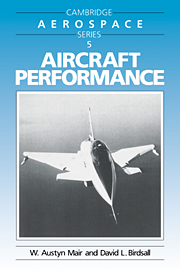Book contents
- Frontmatter
- Contents
- Preface
- Introduction
- 1 Aerodynamic foundations
- 2 Basic flight theory
- 3 Drag equations
- 4 Climbing performance
- 5 Power plants
- 6 Take-off and landing performance
- 7 Fuel consumption, range and endurance
- 8 Turning performance
- 9 Vectored thrust
- 10 Transonic and supersonic flight
- Appendixes
- References
- Index
3 - Drag equations
Published online by Cambridge University Press: 02 December 2009
- Frontmatter
- Contents
- Preface
- Introduction
- 1 Aerodynamic foundations
- 2 Basic flight theory
- 3 Drag equations
- 4 Climbing performance
- 5 Power plants
- 6 Take-off and landing performance
- 7 Fuel consumption, range and endurance
- 8 Turning performance
- 9 Vectored thrust
- 10 Transonic and supersonic flight
- Appendixes
- References
- Index
Summary
The drag acting on an aircraft is of supreme importance in determining either the performance obtainable with a given thrust or the thrust required to achieve a specified performance, the latter being important because for a given speed the rate of consumption of fuel is approximately proportional to thrust. This chapter gives a brief account of the principal components of drag and the essential flow mechanisms on which they depend. Particular attention is paid to the nomenclature used for the drag components and to the conditions for various minima, because the undisciplined use of some of the terms has led to confusion in the past.
The drag polar for an aircraft has been discussed in Chapter 2 and in this chapter the representation of the polar by a simple mathematical expression is considered. The commonly used simple parabolic drag law has the great advantage of allowing many aspects of performance to be expressed in terms of simple equations, but the limitations of this drag law are emphasised and some alternative laws are introduced. In using either the simple parabolic law or any of the alternatives it is important to ensure that the constants in the equations are chosen to give the best possible agreement with the real drag polar over the range of CL that is important.
The flight conditions for minimum drag and for minimum drag power have been discussed briefly in Chapter 2 and in this chapter they are examined in more detail, making use of the parabolic equation for the drag polar mentioned earlier.
Components of drag
The total drag of an aircraft may be regarded as the sum of several components.
- Type
- Chapter
- Information
- Aircraft Performance , pp. 30 - 45Publisher: Cambridge University PressPrint publication year: 1992



